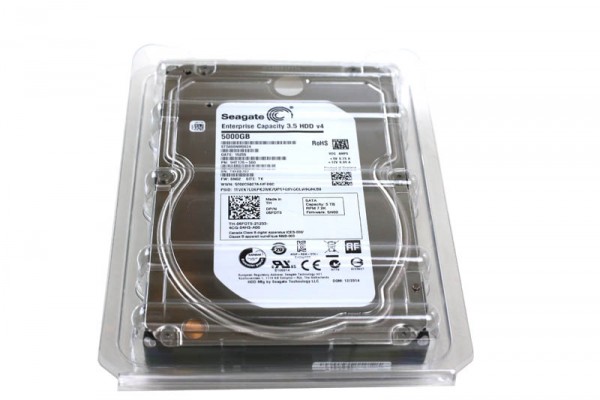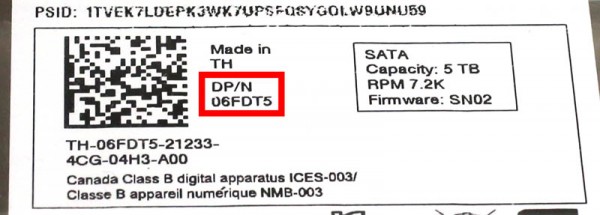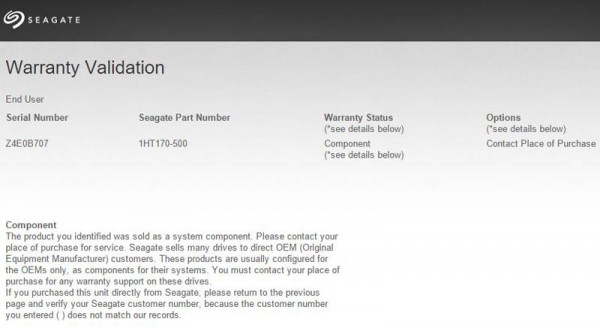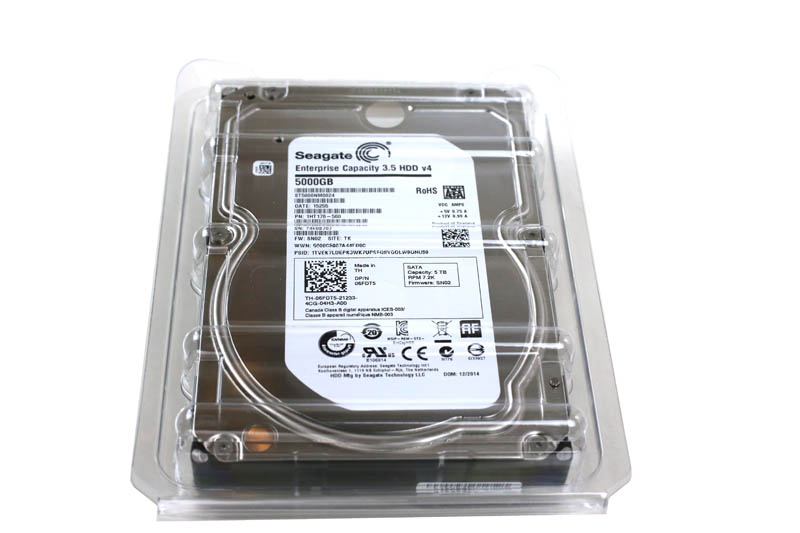As part of our Sunnyvale lab OpenStack build-out, a few hard drives were purchased from different vendors. We purchased a number of Seagate Enterprise Capacity 3.5 HDD v4 drives off of Amazon.com through a seller Platinum Micro. When we received these particular drives a small marking gave us pause. We were able to save ourselves from a potentially expensive experience had one failed.
Here is the drive we received new in its clam shell packaging. Can you spot what is wrong with this picture?

Here is a close-up of the relevant marking:

Dell OEM parts generally have a Dell Part Number (DP/N) marked on them. HP, IBM, Lenovo and others do the same in some manner. For example, HP often utilizes a sticker. The impact of that DP/N is not that this is a bad drive. What it does impact is the ability to get a warranty replacement. The standard warranty on a retail purchased Seagate Enterprise Capacity 3.5 HDD v4 is 5 years. When we put the serial and model numbers into Seagate’s warranty checker, this is what we saw:

That more or less means that Seagate will not honor the standard 5-year warranty on these items.
For a quick reason why OEM hard drives do not have warranty it comes down to volume purchasing. Seagate and OEMs likely have agreements in place so that end customers will warranty to the OEM directly, not Seagate. The OEM and Seagate then likely have an arrangement that provides for acceptable defect rates. This is a standard industry practice and is by no means Seagate specific. Western Digital, Toshiba, SanDisk, Intel and other vendors do the same thing.
As a consumer, especially when purchasing “bare” drives, you should verify with the vendor’s warranty check tool that indeed the drive you purchased does have the appropriate warranty period.
With all of this said, purchasing OEM drives can make sense. Hard disk AFRs are generally in the single digits annually so if you are purchasing a larger number of drives, and get a 20% discount (as an example) then you can essentially self-warranty and use the initial discount to pay for failed drives in the future.





Thanks for the heads up!
Some less honest sellers also list these drives as new, when in fact they should be called “pulls” or similar and you should check the number of hours use the drive has had at delivery. Often, vendors such as Dell pre-load an OS, or put the drive in a RAID array configured for a client so there may be data on these drives or they have had a RAID soak test performed on them which could take 100+ hours. The machine order then get’s cancelled for some reason or another and the vendor sells the machine off in the channel and the buyer breaks the machine up to sell as parts claiming everything is new, fresh from the factory. We come across it a lot buying equipment and it drives us mad as we cannot sell something as new, when it has been used before, whether it be for 1 minute or 1 year. Used is used.
It is always a good idea to check the factory warranty status, regardless of whether the drive appears to be an OEM version or not. Drives can be sitting in the distribution channel for an extended period of time while the factory warranty is ticking away. Most (or all?) drive manufacturers will adjust the warranty to run from the date of initial purchase. The method varies – some want you to register the drive serial numbers, others need an email to customer service. It is better to get this out of the way “up front” – if the drive fails between the end of what the factory thinks the warranty is and what the customer thinks it is, at a minimum there will be a scramble to try to find a years-old receipt (which may or may not list serial numbers). At worst, you won’t be able to find the receipt or you get a “that wasn’t an authorized seller” response from the manufacturer, along with a warranty denial.
Regarding a previous reply about pulls, sometimes the seller is unaware. I ran into this with some 2.5″ Savvio drives – the eBay seller (with 10K+ feednack, so not a fly-by-night) sold the drives as “New – other” and when I received them, I discovered they had 32K+ hours on them. In talking to them, they said they had received a batch of hundreds of these drives from Dell, represented as pulls from unsold storage arrays. They asked for a day to check and then reported back that I was correct. They immediately refunded my purchase and sent me some gift cards for my trouble. A few days later they asked me to send the drives to Dell (not to them, but back to Dell) with an RMA reference. It is certainly possible that this was a scam (and Dell went “Huh?” when they received the drives), but it didn’t feel like it.
I think this applies to tech components in general, not just hard drives. We had a similar situation with Intel NICs. Their retail versions offer lifetime warranties. We had one fail, went to return, and found out it was an OEM version, and therefore not warrantied by Intel. We didn’t notice that at the time, now we know to look out for these kinds of things.